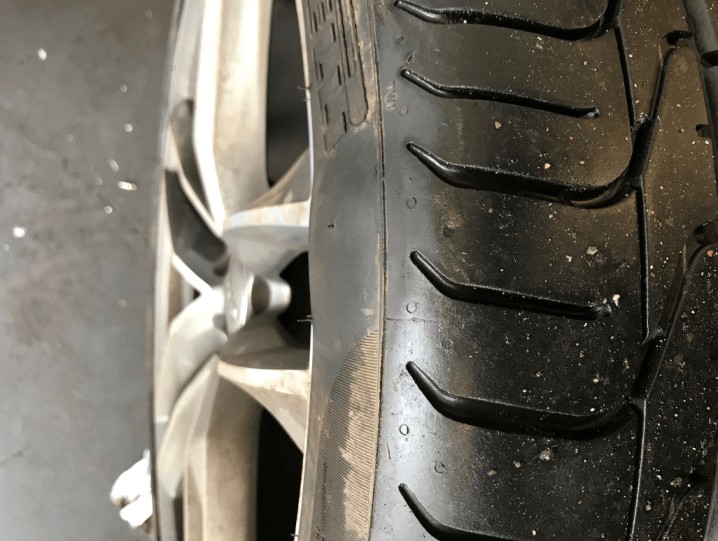A broken belt in a tire is unusual because it may not be worn out or flat yet but needs replacing. It is far more dangerous than a worn-out tire because the tread can lift away from the casing, which always happens when traveling at speeds.
Just to put it straight out there, because of the nature of the issue, a broken belt in the tire cannot be repaired and must be replaced.
That sentence might have saved you from needing to read this article, but unfortunately, replacement is the only option and must happen urgently; you cannot drive on a tire with a broken ply, and this article will explain the reasons in more detail.
What Is a Broken Belt in a Tire?
A broken belt in a tire is when the belt, also known as plies, that runs through the tire has broken. When this happens, the pressure inside the tire forces the broken belts further apart, and bulged rubber appears.
Because the straps are set to hold the tire shape, and when you drive over bumps in the road, they act like a spring pushing the tire back into its manufactured shape. However, when a belt is broken, the rubber swells between the breakage and no longer keeps its shape.
You may have commonly seen an egg on the side of a tire; this is a break in the steel belt that runs through the side of the tire. Usually caused by an impact, the result is a bulge in the sidewall.
A bulge in a tire is not exclusive to the sidewall and can happen on the tread part of the tire, although they generally cover a larger surface area. The tread can peel from the tire casing (delaminate).
What Causes a Broken Tire Belt?
Broken tire belts/plies/bands are usually caused by a combination of the below and rarely by one single cause.
Impact
Impacts to the side of the tire from curbs cause sidewall bulges, which is a common driver-caused problem. However, an impact to the tire tread from driving over debris which causes a break in the belt is rare. When this happens, it’s usually found that the tire is quite old, in which case the belts, rubber, and casing will all be weak.

Age
Tires must be replaced regardless of the tread depth after approximately five years of use to stop these exact sorts of problems. An older tire will have weakness in its construction and the rubber from exposure to the elements and the constant rotation over bumps in the roads.
An older tire with a weak belt can give way at any time, but as already mentioned, it will probably be a large pothole, some impact that finally causes the weak belt to break.
Manufacturing defect
Manufacturing defects in tires are so rare, but they can happen. Each tire component is generally made by each tire manufacturer and not subcontracted out, so they can control the quality. However, problems can slip through, as you would expect with manufacturing such large quantities.
The tire belts are wound steel cables set in a specific arrangement (radial, cross-ply, or bias belted) encased in rubber to protect them. Manufacturing defects such as a belt not adequately aligned and tread not being sealed correctly onto the casing can occur. As you would expect tires to be rigorously tested and rigorous QC procedures to limit problems, you would rarely encounter a tire manufacturing defect.
Cuts in the tire
Cuts causing broken belts are one of the most common reasons a belt breaks. What happens is that a foreign object (sharp rocks) pierces the tread and digs into the belt but doesn’t quite go deep enough to cause a flat tire.
The steel wire belts split, and fray; the broken plies can be seen through the cut where they are exposed to road contaminates, water, and oxygen. The exposure to water and oxygen causes the belts to rust, which breaks more belts, and then you have a tire not fit for purpose.
Broken Belt in Tire Symptoms
Steering problems
The first thing that’s usually noticed is the unusual behavior of the steering wheel when driving. The steering can suddenly snatch to one side or feel odd when trying to turn at low speeds. This is a bulge on the tire tread flexing and moving while trying to steer. If you managed to get up to 30 mph, the steering wheel and car would shake violently.
Vibrations
Because when a tire band breaks, there is no reinforcement, the tire changes shape, which you feel as you drive. Imagine driving to go with eggs as tires; you would hear and feel every rotation. It would be impossible to do any more than a few mph because of the vibrations. Depending on how bad the tire is, severe shaking could worsen the faster you drive.
Noise
Noise pretty much follows vibrations. When a tire band breaks, the tread can delaminate, and you can hear this as you drive; you may listen to chunks of tread being ripped from the tire. You may only hear the vibration because the tire is no longer a circle shape but now slightly oval shaped.
It will only take a couple of miles for tire to completely change shape in which case the noise from the suspension and offending will be just as loud as the engine.
Tire visibly changed
The tire will visibly be different; it will no longer be round and may look like it has a growth in the tread. Sometimes this is just visible when on the car still as a bold patch (flat spot) in the tread when the rest of the tire has lots of tread left.
Sometimes you can even see the tread lifting and broken wires exposed; this is the broken tire band causing a problem.
Is It Safe to Drive With a Broken Belt in the Tire?
A tire with a broken band is not safe to drive on. The tire tread can delaminate and rip away as you drive, resulting in a flat tire very quickly. If you notice a tire that is bulged or unusually deformed, removes the tire immediately and fit the spare tire.
Do not attempt to drive on the tire if the tread has bulged or is misshapen, even if it is still fully inflated; the bulged air is not supported by the tire bands anymore and will shred with little warning.
Summary
To summarise, a broken belt in a tire means the reinforcing steel wires that keep the tire in shape have broken. If you drive with it, the tire will burst and shred quickly. Even worse, the tire can delaminate the tread before deflating, so you may only have some vibrations or noise as a warning.
As soon as you suspect a broken tire belt, you should remove the tire and take it to a tire garage for inspection/replacement.









